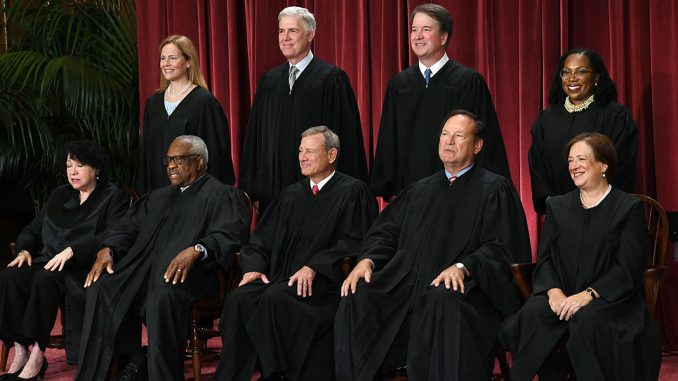
Today, the Left is complaining about the very judicial independence that was among the reasons that America declared independence from England.
Most Supreme Court justices take the Constitution as it is, refusing to make one up to promote certain political interests. The Left responds by mearing those justices as “unethical” and trying to intimidate them by demanding that the Supreme Court adopt a code of conduct like the one that lower court judges follow.
On Monday, the Supreme Court took that step, but—no surprise here—it won’t satisfy the Left.
Understanding this conflict requires keeping two principles in mind. First, the Constitution separates government power into three branches, limiting the control that each has over the others. Second, the Constitution, not Congress, created the Supreme Court and, therefore, Congress has less control over the Supreme Court than over the lower federal courts that it creates.
Issues of judicial ethics fall into three categories: financial disclosure, recusal, and activities off the bench. A federal statute, the Ethics in Government Act, requires that all federal judges, including Supreme Court justices, file detailed disclosures about everything from the “source, type, and amount or value of income” to interest in property, liabilities, and even purchases, sale, or exchanges that exceed $1,000.
The “contents of reports” section of the statute is nearly 18 pages long. Another federal statute requires federal judges and justices to step away from handling cases in which their “impartiality might reasonably be questioned.”
Much of the current conflict concerns the third category of issues. The Left pushes the false notion that the Supreme Court has no ethical guidelines because, unlike lower court judges, it has not issued its own “code of conduct.”
In 1948, Congress created the Judicial Conference of the United States, made up of judges from various federal courts, to set internal judiciary policy. The Judicial Conference in turn issued the Code of Conduct for United States Judges, or CCUSJ, in 1973 and said it was “designed to provide guidance to judges.”
What the Left does not say is that the Supreme Court has twice formally pledged to use the CCUSJ in the same way that lower court judges do—consulting it for guidance. That’s not good enough for activists on the Left, and they’ve been demanding that the Supreme Court issue its own code.
So now the Supreme Court has done just that, issuing its so-called Code of Conduct for Justices of the Supreme Court of the United States. Guess what? It’s virtually identical to the code for lower court judges that Supreme Court justices have been following all along.
There are some tweaks here and there, substituting “justices” for “judges,” consolidating commentary that accompanies each section of the original and putting it all at the end, that sort of thing. The new code has the same five “canons” stating what judges or justices “should” or “may” do, such as “perform[ing] the duties of the office fairly, impartially and diligently” or “uphold[ing] the integrity and independence of the judiciary.”
Who could argue with that?
The Left, that’s who. The CCUSJ, you see, is connected to the Judicial Conduct and Disability Act, which Congress passed in 1980 to help enforce the code of conduct for lower court judges.
This law provides for a process in which individuals may file complaints that a federal judge has “engaged in conduct prejudicial to the effective and expeditious administration of the business of the courts.” Those complaints are handled first within the judicial circuit in which a targeted judge serves, but the circuit has few disciplinary options.
The Left wants a similar enforcement process for the Supreme Court, but here’s where the fundamental differences between the Supreme Court and the lower courts are important. Congress created the lower courts with an organizational and administrative structure that does not exist in the single, nine-member Supreme Court.
Neither the Judicial Conference as a whole, nor any of its judicial components, has any authority over the Supreme Court. Congress cannot impose upon the Supreme Court the disciplinary process that it established for the courts it creates.
Sen. Sheldon Whitehouse, D-R.I., has introduced legislation to create a way for individuals to file unlimited complaints against Supreme Court justices for virtually any reason. Not surprisingly, Whitehouse issued a statement following the Supreme Court’s release of its code of conduct, complaining that the code includes no “mechanism to investigate and make recommendations based on those complaints.”
That’s what the Left really wants: a way to investigate and hopefully manipulate what the Supreme Court does. That way, the court’s decisions will be more in line with the Left’s political interests.
So, in the end, Supreme Court justices have committed themselves to the framework of ethical standards that have guided them, and all federal judges, for decades.
That’s something, but not something new. It’s no wonder that America’s Founders made judicial independence such a priority.
Have an opinion about this article? To sound off, please email letters@DailySignal.com, and we’ll consider publishing your edited remarks in our regular “We Hear You” feature. Remember to include the URL or headline of the article plus your name and town and/or state.

Be the first to comment